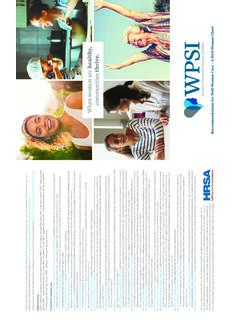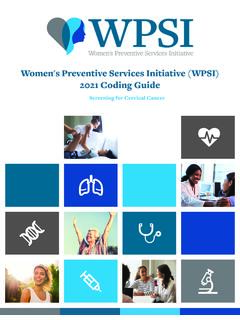Transcription of Women's Preventive Services Initiative (WPSI) 2020 Coding ...
1 Women's Preventive Services Initiative (WPSI)2020 Coding GuideWomen's Preventive Services Initiative (WPSI)2020 Coding GuideiviiiAll diagnosis codes referred to in Women s Preventive Services Initiative (WPSI) Coding Guide were excerpted from the International Classification of Diseases, 10th Revision, Clinical Modification (ICD-10-CM), October 2019 revision, published by the United States government under the auspices of the ICD-10-CM Coordination and Maintenance Procedural Terminology (CPT), Fourth Edition, copyright 2019 American Medical Association (AMA). All rights reserved. Fee schedules, relative value units, conversion factors, and/or related components are not assigned by the AMA, are not part of CPT, and the AMA is not recommending their use.
2 The AMA does not directly or indirectly practice medicine or dispense medical Services . The AMA assumes no liability for the data contained or not contained herein. Applicable FARS/DFARS restrictions apply to government use. CPT is a registered trademark of the American Medical project was supported by the Health Resources and Services Administration (HRSA) of the Department of Health and Human Services (HHS) under grant number UHOMC29940, Bright Futures for Women s Health: Standard Practice Guidelines for Well-Women Care. This information or content and conclusions are those of the author and should not be construed as the official position nor policy of, nor should any endorsements be inferred by HRSA, HHS, or book is provided by the American College of Obstetricians and Gynecologists (ACOG) for educational purposes only.
3 It is not intended to represent the only, or necessarily the best, Coding format or method for the situations discussed, but rather as an approach, view, statement, or opinion that may be helpful to individuals responsible for diagnosis and procedure Coding . The statements made in this publication should not be construed as ACOG policy or procedure, nor as standards of care. The American College of Obstetricians and Gynecologists makes no representations or warranties, expressed or implied, regarding the accuracy of the information contained in this book and disclaims any liability or responsibility for any consequences resulting from or otherwise related to any use of, or reliance on, this book. Please reference the CPT manual for complete procedure code descriptions along with additional CPT Coding instructions and s Preventive Services Initiative (WPSI) Coding Guide 2020 was developed by WPSI s Dissemination and Implementation Steering Committee and ACOG s Coding Department.
4 ACOG Practice Activities Division Staff: Michelle Jones, MScSarah Son, MPHB ushra IdlibiNancy O Reilly, MHSC hristopher Zahn, MD Col (Ret), USAF, MCACOG Health Economics Department Coding Staff: Donna Tyler, CPC, COBGCM iroslava Rudneva, MS, RHIT, CCS, COBGCC opyright 2020 by the American College of Obstetricians and Gynecologists. All rights reserved. No part of this publication may be reproduced, stored in a retrieval system, posted on the internet, or transmitted, in any form or by any means, electronic, mechanical, photocopying, recording, or otherwise, without prior written permission from the College of Obstetricians and Gynecologists409 12th Street SW, Washington, DC 20024-2188 Suggestions and comments are welcome. Address your comments to the following:American College of Obstetricians and Gynecologists (ACOG)Division of Practice ActivitiesWomen s Preventive Services Initiative (WPSI)409 12th Street SWWashington, DC 20024-2188 Telephone: (202) 863-2498 Fax: (202) 484-3993E-mail: DISCLAIMER AND COPYRIGHT NOTICESvivIntroduction Introduction to Coding for the Women's Preventive Services Initiative (WPSI) Recommendations.
5 2 Preventive Medicine Services Preventive Medicine Services ..4 WPSI Recommendation Coding Breast Cancer Screening for Average-Risk Women ..7 Breastfeeding Services and Supplies ..9 Screening for Cervical Cancer ..13 Contraception ..16 Screening for Anxiety ..27 Screening for Diabetes Mellitus After Pregnancy ..30 Screening for Gestational Diabetes Mellitus ..32 Screening for Human Immunodeficiency Virus Infection ..34 Screening for Interpersonal and Domestic Violence ..38 Counseling for Sexually Transmitted Infections ..41 Screening for Urinary Incontinence ..43 Well-Woman Preventive Visits ..47 Appendix A Appendix A Medicare ..49 Appendix B Appendix B Medicaid ..69 CONTENTSWPSI 2020 Coding Guide | 2 IntroductionIntroduction to Coding for theWomen's Preventive Services Initiative (WPSI)RecommendationsCorrect medical Coding for Services rendered by physicians and other health care providers is an expectation of federal, state, and private payers and required by the False Claims Act.
6 This document acts as guidance to assist practices with Coding and billing Preventive Services for women and was developed in consultation with staff of the American College of Obstetricians and Gynecologists (ACOG). Coding BasicsThere are several code sets used for different purposes. In this resource, two primary code sets will be discussed. For medical claims there are three primary sets: Current Procedural Terminology (CPT) , Healthcare Common Procedure Coding System (HCPCS) Level II, and International Classification of Diseases, Tenth Revision, Clinical Modification (ICD-10-CM).Each of the key code sets serves a different purpose. CHECK-CIRCLE CPT/HCPCS codes describe what service was provided. CHECK-CIRCLE ICD-10-CM codes describe why a service was must document and code both what and why for each Health Insurance Portability and Accountability Act of 1996 (HIPAA) requires that electronic transmissions of health care claims and encounter information meet certain standards, including the adoption of uniform code sets.
7 ICD, CPT, and HCPCS Level II codes are the only approved code sets when information is exchanged electronically. Another standard adopts certain requirements for the submission of electronic claim codes are 5-digit alphanumeric codes developed and copyrighted by the American Medical Association. They comprise the primary set of codes used to describe the cognitive and procedural Services provided by a physician s Level II National codes are 5-digit alphanumeric codes developed and maintained by the Centers for Medicare & Medicaid Services (CMS), America s Health Insurance Plans (AHIP), and the Blue Cross Blue Shield Association (BCBSA).Some level II codes are considered permanent national codes. These codes are maintained by the HCPCS National Panel, which consists of representatives from CMS, AHIP, and BCBSA.
8 Level II codes are used to report Services not covered by CPT codes, such as durable medical equipment (DME) and supplies. The Centers for Medicare & Medicaid Services updates these codes annually. Level II codes must be used for Services reported to Medicare and Medicaid. Other payers may or may not recognize Level II codes for reimbursement. It is advisable to check with specific payers regarding their billing and reimbursement example is J Coding . Healthcare Common Procedural Coding System codes that begin with a J describe drugs administered by a method other than oral administration. These codes are required under HIPAA regulations and identify drugs and 2020 Coding Guide | 43 Other Level II codes are temporary national codes.
9 These codes were developed to meet, within a short time frame, the operational needs of a particular insurer that are not addressed by an already existing national code. Any member of the HCPCS National Panel can establish a temporary national code that can be used by other insurers. Examples are the codes developed by CMS to report those portions of Preventive medicine Services covered by codes often are complemented by 2-digit modifiers. Modifiers provide the means to indicate that a service or procedure has been altered by some specific Classification of Diseases, Tenth Revision, Clinical Modification (ICD-10-CM), is a clinical modification of the World Health Organization s (WHO) ICD, which is used worldwide to track morbidity and mortality statistics and is the standard for diagnosis Coding in the United States.
10 The word clinical emphasizes the intent to describe the clinical picture of the patient. This code set uses codes to identify the patient's diseases, signs and symptoms, abnormal findings and complaints, social circumstances, and external causes of injury or disease or other reasons for seeking medical care. The tenth edition of ICD-10-CM was adopted by WHO in 1994 and is currently used worldwide. In addition to data collection, it is used to convey the medical necessity of the service to third-party tenth edition of ICD-10-CM codes support the medical necessity for performing a service. The physician must clearly indicate the reason(s) for all the Services rendered to ensure the selection of the most specific code. Correct Coding implies that the code selection is: CHECK-CIRCLE The most accurate description of what was performed and why it was performed CHECK-CIRCLE Supported by documentation in the medical record CHECK-CIRCLE Consistent with Coding conventions and guidelinesWhen selecting ICD-10-CM diagnosis(es) for an encounter, the diagnosis code(s) must support the clinical need (medical necessity) for the service as described by the CPT code.


